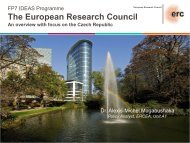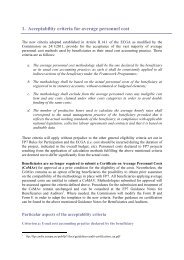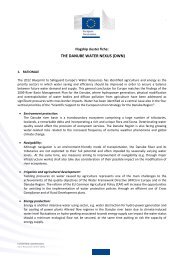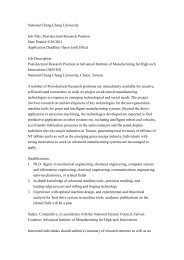Guide to Research and Innovation Strategies for Smart Specialisation
Guide to Research and Innovation Strategies for Smart Specialisation
Guide to Research and Innovation Strategies for Smart Specialisation
You also want an ePaper? Increase the reach of your titles
YUMPU automatically turns print PDFs into web optimized ePapers that Google loves.
• Finally, radical foundation of a new domain: The discovery here is that R&D <strong>and</strong><br />
innovation in a certain field can make previously low growth activities suddenly become<br />
attractive. Such radical foundation involves the co-emergence of R&D / innovation <strong>and</strong><br />
related entrepreneurial activity. For example, the development of IT applications <strong>for</strong> the<br />
management <strong>and</strong> maintenance of the archaeological <strong>and</strong> his<strong>to</strong>rical heritage in Italy<br />
(Florence) is a good example of the co-emergence of an R&D / innovation area <strong>and</strong> a niche<br />
market.<br />
<strong>Smart</strong> specialisation is not about creating technology monoculture <strong>and</strong> uni<strong>for</strong>mity; on the<br />
contrary, it is likely <strong>to</strong> promote greater diversity. Indeed, regions can sustain multiple lines of<br />
smart specialisations (priorities). Most of the above structural changes generated by smart<br />
specialisation strategies actually involve the creation of variety, such as the transition <strong>to</strong> new<br />
activities or the diversification of existing sec<strong>to</strong>rs.<br />
In particular, strategies aimed at fostering cross-sec<strong>to</strong>ral or cross-border cooperation have proven<br />
<strong>to</strong> be successful in generating ideas <strong>for</strong> new innovative applications <strong>and</strong> integrated solutions.<br />
Cross-sec<strong>to</strong>ral links can provide a region with the degree of originality <strong>and</strong> specialisation <strong>to</strong><br />
differentiate itself <strong>and</strong> provide a competitive advantage vis-à-vis other regions.<br />
Where: A role <strong>for</strong> every region<br />
The smart specialisation concept can be used in all regions, even though some are more<br />
advanced in terms of knowledge production. However, the application of the concept in a<br />
regional context has <strong>to</strong> be approached with care because the economic <strong>and</strong> institutional context<br />
varies considerably between <strong>and</strong> within European regions.<br />
This means that a <strong>Smart</strong> <strong>Specialisation</strong> strategy needs <strong>to</strong> take in<strong>to</strong> account several geographically<br />
specific characteristics <strong>to</strong> help generate growth in regions. In this respect the following points<br />
need <strong>to</strong> be considered when applying smart specialisation <strong>to</strong> the regional context, 16 as explained<br />
also in Part III <strong>and</strong> Annex I of this document:<br />
• The entrepreneurial process of discovery will work differently in every region: In some<br />
places the process will be quite evident due <strong>to</strong> the high density of innova<strong>to</strong>rs <strong>and</strong><br />
entrepreneurs (usually core-cities). However, the process will be much harder in other<br />
regions characterised by low population, a small number of sec<strong>to</strong>rs <strong>and</strong> large dominant<br />
firms but with few external links. In this case, links between local universities <strong>and</strong> strong<br />
public-private partnerships are the types of strategies that may be essential <strong>for</strong> smart<br />
specialisation <strong>to</strong> work.<br />
• Identifying sec<strong>to</strong>rs that can achieve critical mass should take in<strong>to</strong> account the 'principles of<br />
regional embeddedness <strong>and</strong> relatedness'. The first principle of 'embeddedness' refers <strong>to</strong> the<br />
16<br />
These points are based on a working paper by Phillip McCann <strong>and</strong> Raquel Ortega-Argilés (2001), '<strong>Smart</strong><br />
<strong>Specialisation</strong>, Regional Growth <strong>and</strong> Applications <strong>to</strong> EU Cohesion Policy', Groningen University.<br />
15

















